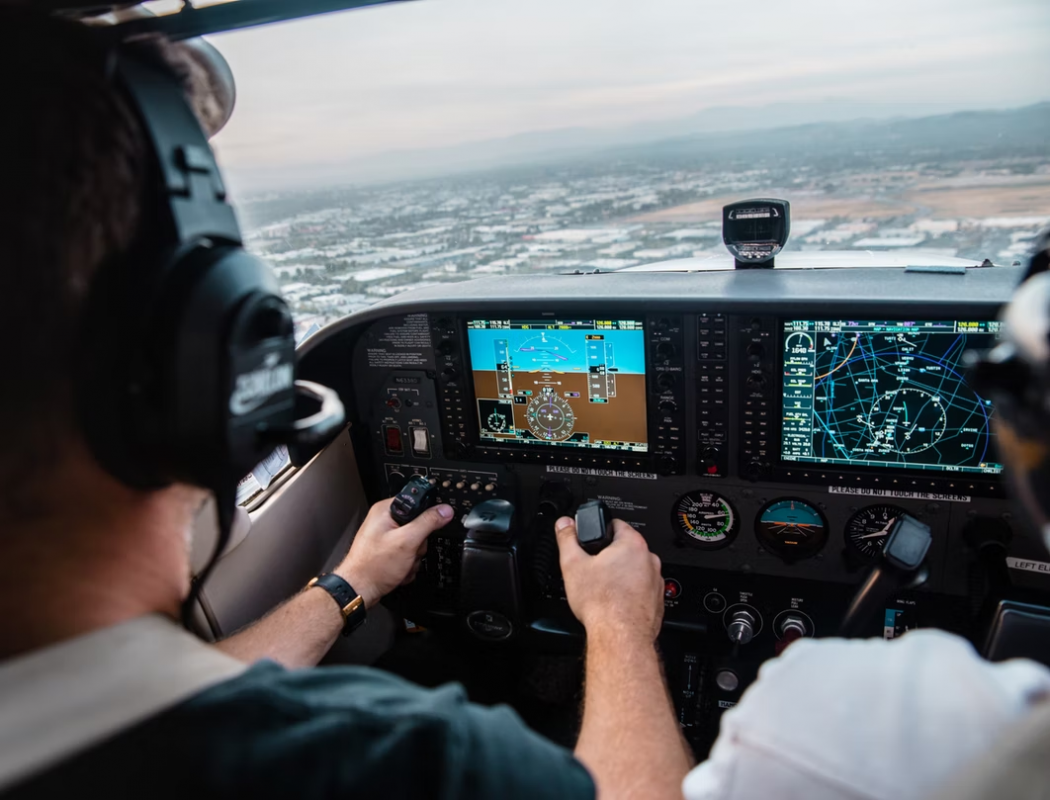It may seem scary to think about a pilot not being able to recognize certain colors while flying an airplane, there are ways around this problem. If you or someone you know has been diagnosed with colorblindness and is considering becoming a pilot, read on. This article has more about how it might affect your career as a pilot.
If you are colorblind, you can still become a pilot.
You can become an airline pilot with color vision deficiency. Some airlines will disqualify applicants with severe colorblindness. A color vision deficiency does not mean that your eyesight is impaired or in any other way unable to perform the tasks required of pilots. You do not need 20/20 vision for flying—in fact, even people who are legally blind can fly as long as they pass all other tests.
There are three types of colorblindness (color vision deficiencies).
There are three types of colorblindness (color vision deficiencies). These include:
- Most colorblind people have red-green colorblindness. It is the most common form of color blindness. It affects 8-12% of men and 0.5-1% of women. In red-green colorblindness, people struggle to tell red from green. They also have trouble with shades of these colors.
- Blue-yellow colorblindness(dichromacy), which affects about 1 in every 10 men and less than 1 in every 100 women. People with this type have trouble distinguishing between blues and yellows as well as some shades within these two colors.
- Total color blindness is rare but serious. It causes individuals to see only shades of gray. They can’t see any other colors, even with corrective lenses.
In general, only those with red-green color blindness will be disqualified from flying. This is due to poor vision.
How do I know if I am colorblind?
To find out if you have a color vision deficiency, there are several tests that can be used. The most common is the Ishihara test. In it, you have to identify a number or symbol. You do this by looking at a series of circles filled with dots of different colors. Some symbols are easier to see than others depending on whether or not you have normal color vision.
You want to test if you are totally color blind, not just red-green deficient. The Farnsworth-Munsell 100 hue test is proven and still widely used. It has two charts. Each has large blocks of about 10 shades. They let patients with normal vision see subtle differences. But, those with red-green colorblindness will struggle to identify them all.
The Cambridge Color Test involves analyzing how quickly subjects can match colored disks. The disks are shown as pairs (A:B) against solid backgrounds (A:C). Quick completers may suffer from some tritanopia. Slow ones may suffer from protanopia. The slowest will likely be dichromats. They can’t see violet at all!
Pseudo-isochromatic plates are another popular test for diagnosing red-green color blindness. They only need one quick glance from participants. But, these plates must be viewed under specific lighting conditions (e.g., daylight). This makes it hard for many people outside North America to use them. They lack the needed lighting outdoors and indoors at night. Artificial lights at night give off non-white light. This interferes with the results, even though both types of light look the same during the day.
No matter what type of pilot you want to be, you must have a certain level of color vision.
If you are colorblind and want to be a pilot, you can still fly. There are many different types of flying jobs available to people with impaired color vision. But, if you want to be a commercial or military pilot, then only one type of flying counts—the private sector.
Private pilots don’t carry passengers or cargo. They just enjoy flying their own planes for fun or business. Private pilots need good depth perception. This helps them avoid crashing into obstacles while landing and taking off from small airports without runways. Private pilots also need good side vision. They use it to scan the sky for other aircraft. They do this before moving through it during takeoffs and landings.
The FAA does not need all private pilots to have perfect color vision. But, if your doctor thinks your color blindness will make it unsafe for you to fly an aircraft—or endanger others—he must note this on his medical report. Then he can issue your licenses.

(Source)
The requirements for certification and for flight also vary. It depends on whether you are applying for a Private Pilot License (PPL), Commercial Pilot License (CPL) or Airline Pilot License (ATPL).
This is the most important part: there are no specific color-blindness requirements for private pilots. In fact, there are no regulations that specify any particular eye condition at all. As long as you can pass your vision test, you’re good to go. The test needs 20/40 vision with or without glasses (or a score of +2 on the Snellen eye chart) in one eye and 20/70 in the other.
The requirements for commercial pilots are slightly stricter. You must have 20/100 vision in each eye, with or without correction. If you are too colorblind to pass this test, the person who reviews your certification application can give you a waiver. But, only if you’ve trained at an FAA-approved facility and shown you know aircraft safety procedures before flying solo. For example, by passing an oral exam. However, these waivers are hard to get. They are rarely granted if they exist. It might be better to not apply at all until after your treatment has improved your eyesight enough. Then, you won’t need any special permission anymore!
You can be a pilot if you are colorblind, but there are some tests you must take
As you might know, pilots are required to pass a series of tests. These exams evaluate their physical and mental health.
One such test is the Pilot’s Medical Certificate (Pip) test, which is given by an aviation medical examiner (AME). This test ensures all pilots are fit to fly safely. It looks at things like color vision and hearing, heart rate, blood pressure, lung capacity, and muscle strength.
If you pass the PIP test, you may be issued a class 1 or 2 medical certificate and can be a pilot.
If you pass the PIP test, you may be issued a class 1 or 2 medical certificate and can be a pilot. The FAA will send you a letter. It will confirm the testing facility’s results. You need to give this letter to your flight school when applying for training.
In order for the PIP test to be administered, it must be given at an FAA-approved facility by an FAA-certified doctor during the medical exam.
If you fail the PIP test, you are issued only a class 3 medical certificate
There are some limitations on your license if you fail the PIP test. You will get only a class 3 medical certificate. It lets you fly only aircraft with basic instruments, i.e., no electronic “glass” cockpits. This means that:
- You cannot fly at night or in weather conditions less than minimums for visual flight rules (VFR) and instrument flight rules (IFR).
- You cannot fly into IMC or over water above a specified distance from shore, whichever is greater. The distance varies among countries. In the U.S., it’s about 50 miles from shore to be considered open water. This is rather than over land or cities and towns.
- There is more. Certain types of airspace have rules. For example, pilots need an instrument rating. They also need special clearance from air traffic control to enter military training zones.
The FAA regulates the requirements for color vision for each type of pilot’s license.
The FAA regulates the requirements for color vision for each type of pilot’s license.
To fly as a private pilot, you must have normal color vision with or without glasses (glasses are allowed). If you are colorblind, it is acceptable if you can distinguish between red and green lights with your corrective lenses in place.
To get an instrument rating, an applicant must pass a visual acuity test. It shows 20/40 vision in one eye and 20/70 in the other eye at 16 inches or more from the eyes. An applicant who has passed this test may wear any needed correction (glasses or contacts). They can wear them during both daytime and nighttime operations. But, this does not mean they will meet other requirements for night flying (see below).
The FAA requires people who wear glasses at all times while flying (even with good vision) to wear them during instrument flight. This is when IMC requires them, as stated in Part 91K–1. Part 91K–1 is published by AOPA Air Safety Foundation. It is about the requirements for Instrument Flight Rules Training Course. It is in the document “Guidelines & Curricula Requirements For Pilot Training Programs [PTRS-01508].” Before taking off in such conditions, pilots should check their aircraft paperwork. They need to see if there are extra requirements for eyewear use during IMC flight. These rules are due to specific aircraft equipment on their models.
The FAA allows pilots with a complete color blind deficiency to fly during daylight hours in us
The FAA allows pilots with a complete color blind deficiency (black and white vision only) to fly during daylight hours in the United States. Someone with this level of color blindness can pass the FAA’s standard eye exam. They can also pass its special light testing. This testing is done with a blue light or red-green filter.
FAA restricts pilots with any form of red-green color deficiency from flying at night. Colorblindness can be further divided into three types:
- Protanopia – Red and green are confused, leaving only blue, yellow and violet as distinct colors.
- Deuteranopia – Red and green are confused, leaving only blue, yellow and orange as distinct colors.
- Tritanopia is a type of color blindness. Blue is confused for red and green. This leaves black or white as the only colors the person can see accurately.
In other countries, however, the rules are different. In Canada, for example, if you have any color blindness—even if it’s just one shade off from perfect vision—you can’t get a pilot’s license. Unless you have surgery to fix it. The same goes for many European countries too. You’ll need surgery before you start flying commercial jets abroad!
Also, global regulators have rules for the vision and color vision of pilots. These pilots are licensed outside their home country but fly regularly across borders. This is becoming more common. There is also an international agreement called Annex 1. Member states of ICAO signed it in 2011. It sets minimum standards for medical certification among all nations involved in civil aviation.”
In addition, this flight rule bans night flights. Pilots with red-green color blindness must also get a medical exam. It includes an eye check every 5 years. They must start at age 40 or if their vision changed since the last exam before 40 (This requirement applies even if you’ve never had an eye issue).

(Source)
You need to be able to see the various shades of red and green
You need to be able to see the various shades of red and green if you are going to be a pilot.
The FAA requires a certain level of color vision for each type of pilot’s license. There are three levels:
- Normal Color Vision (no restriction)
- Color Deficiency in One Eye Only (green or yellow filters)
- Color Deficiency in Both Eyes (green or yellow filters), which is the most common type of color blindness.
Medical conditions will determine whether you can get a license as a pilot.
You know someone who wants to be a pilot but struggles to read the cockpit instruments. This is due to poor vision or colorblindness. But, it should not limit their career! Proper training and enough practice using instruments and charts can be done without perfect vision. Anyone can become an excellent pilot with them, no matter their eyesight or brain function. They only need to be healthy enough to pass required tests. These include FAA physical exams every six months. Pilots have them when renewing their licenses every five years.
There is equipment that helps with some types of color blindness when it comes to flying an aircraft.
First, you can use color blind contact lenses. They are available at some vision correction centers. If you’re unsure of where to get them, a quick review of the below product should help point you in the right direction.
Also, there are glasses for color blindness that help with certain types by blocking some colors. Even if you have trouble telling red and green (like me) or yellow and blue, these glasses will let you see more accurately. They are useful for flying or using a camera.
These two options are great if they work for your situation. But if not, there is another option: wear sunglasses! The bright sun reflecting off water or snow can be hard for many color-blind people. So, wearing sunglasses is good advice if it’s sunny and especially if rain might come. They will make everything easier to see without any extra equipment needed!
Last Thought
Can you be a pilot if you are colorblind,Yes.If you are color blind, do not despair. It is possible to pass the test and become a pilot. You have many options. These include night vision goggles and other tools. They make flying easier for colorblind pilots.


